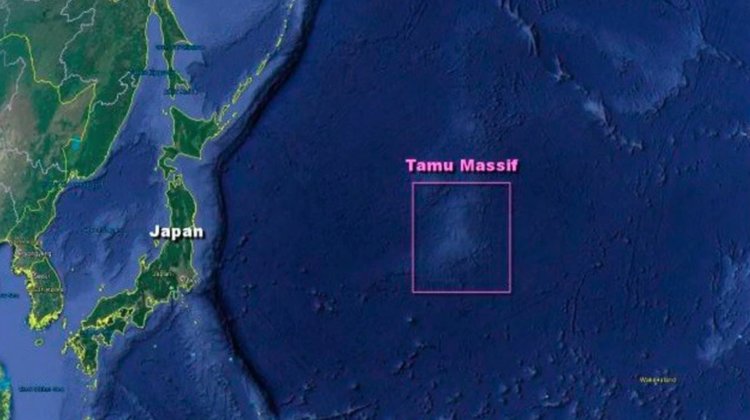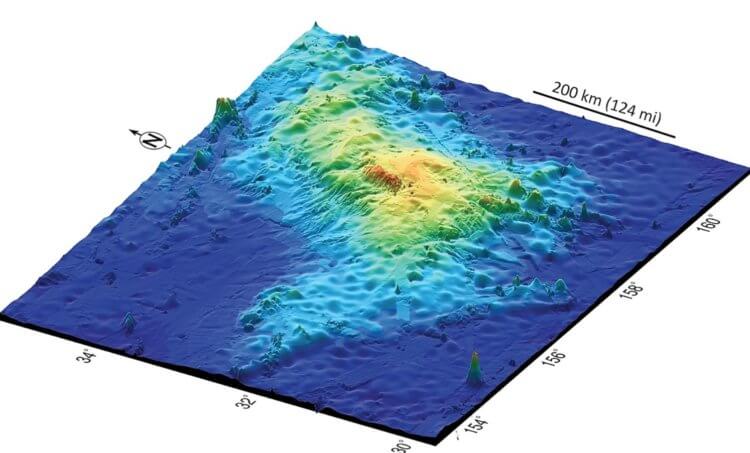There are approximately 1,500 active volcanoes on Earth that have erupted at least once in the last 10,000 years. In addition to active volcanoes, there are even more extinct ones that erupted millions of years ago and today do not pose any danger to us. The largest volcano on Earth is the Tamu Massif, which is located under the waters of the northwestern Pacific Ocean, 1600 kilometers from Japan. It is believed to have formed approximately 145 million years ago and died out almost immediately. The discovery of this volcano is a very interesting story that is definitely worthy of your attention. Initially, scientists did not even suspect how amazing an object they were dealing with.

Earth is home to one of the largest volcanoes in the Solar System
Contents
- 1 The height of Tamu volcano
- 2 The highest volcano in the world
- 3 How volcanoes are formed
- 4 The highest volcano in the solar system
The height of Tamu volcano
The Tamu massif is an underwater volcano that is considered the largest on the ground. Moreover, it is one of the largest volcanoes in the solar system, second only to the Martian extinct volcano Olympus.
The dimensions of the Tamu massif are approximately 450 by 650 kilometers. The height of the largest volcano is 4.5 kilometers, the peak is 2 kilometers below sea level. It is much higher than the tallest active volcano, Mauna Loa, which is located in Hawaii and rises 4.1 kilometers.

Volcano Tamu is difficult to spot because it appears as a gentle rise on the ocean floor. At the top the slope is only 1 degree. For comparison, the average slope of a staircase is approximately 40 degrees, and an easy ski slope has a slope of 10 degrees. Details about the volcano were told by the editors of National Geographic.
Read also:There are at least 1,500 active volcanoes in the world
The highest volcano in the world
h2>
Scientists knew already at the beginning of the 20th century that there was high ground in the northwestern part of the Pacific Ocean. They mapped it, but couldn't say exactly what it was.

Tamu Massif is located relatively close to Japan. Source: nationalgeographic.com
Over time, it was suggested that this hill was formed as a result of the eruption of several volcanoes. But after studying the traces of lava flows, they were surprised to find that they came from one point. So it became clear that there was a huge volcano at the bottom of the Pacific Ocean. It was given the name Tamu – this is an abbreviation for Texas A&M University, whose specialists made the scientific discovery.
You will be interested in: The most largest volcanic eruptions in human history
How volcanoes form
According to scientists, the Tamu massif was formed approximately 145 million years ago. This happened relatively quickly, within about a million years. After the eruption, the volcano quickly went extinct and is unlikely to wake up again.
It is assumed that the formation of the Tamu volcano is due to the coincidence of several factors. Firstly, it is located on the border of three tectonic plates. Secondly, the earth's crust underneath could be thinner than in the surrounding space. Thirdly, the Tamu massif area could be a magma accumulation. It is not clear how it came out, but it is assumed that a crack formed in the earth’s crust.

Tamu Massif on the map of the Pacific Ocean floor. Source: Eurekalert
The Tamu massif was originally thought to be a shield volcano. This is the name of a type of volcano with a wide shape, reminiscent of a warrior’s shield. They are usually formed from lava, which has low viscosity and easily spreads over long distances. But in 2019, scientists suggested that the Tamu massif is the result of spreading, the gradual movement of lithospheric plates under magma pressure.
The highest volcano in the solar system
Most likely, the Tamu massif is the second largest volcano in the solar system. It is possible that there are more volcanoes in the depths of the ocean and other planets, but today the rating looks like this.
The largest volcano in the solar system is Olympus Mons on Mars. It is approximately 26 kilometers high and last erupted about 2 million years ago. The Martian volcano Olympus Mons is not active today, but it has apparently erupted frequently over many millions of years. This is hinted at by the fact that its diameter is 25 times its absolute height.

Olympus Volcano on Mars. Source: o-kosmose.ru
Do you want to know even more about the world around us?Then subscribe to our Zen channel!
Perhaps in the future scientists learn even more interesting details about the Tamu massif. But while there is no such data, you can read our material about the Mauna Loa volcano. It is the largest active volcano on Earth and erupted as recently as 2022. You can look at photographs of the eruption of the tallest volcano in the world right now.